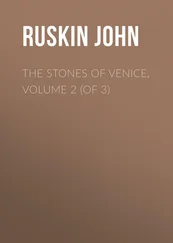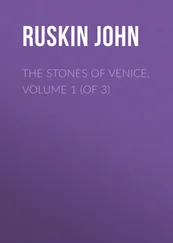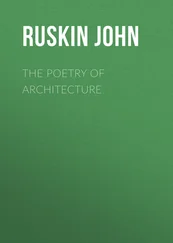1. Santa Fosca, Torcello.
2. North transept, St. Mark’s, Venice.
3. Nave, Torcello.
4. Nave, Torcello.
5. South transept, St. Mark’s.
6. Northern portico, upper shafts, St. Mark’s.
7. Another of the same group.
8. Cortile of St. Ambrogio, Milan.
9. Nave shafts, St. Michele, Pavia.
10. Outside wall base, St. Mark’s, Venice.
11. Fondaco de’ Turchi, Venice.
12. Nave, Vienne, France.
13. Fondaco de’ Turchi, Venice.
14. Ca’ Giustiniani, Venice.
15. Byzantine fragment, Venice.
16. St. Mark’s, upper Colonnade.
17. Ducal Palace, Venice (windows.)
18. Ca’ Falier, Venice.
19. St. Zeno, Verona.
20. San Stefano, Venice.
21. Ducal Palace, Venice (windows.)
22. Nave, Salisbury.
23. Santa Fosca, Torcello.
24. Nave, Lyons Cathedral.
25. Notre Dame, Dijon.
26. Nave, Bourges Cathedral.
27. Nave, Mortain (Normandy).
28. Nave, Rouen Cathedral.
§ VI. Eighteen out of the twenty eight varieties are Venetian, being bases to which I shall have need of future reference; but the interspersed examples, 8, 9, 12, and 19, from Milan, Pavia, Vienne (France), and Verona, show the exactly correspondent conditions of the Romanesque base at the period, throughout the centre of Europe. The last five examples show the changes effected by the French Gothic architects: the Salisbury base (22) I have only introduced to show its dulness and vulgarity beside them; and 23, from Torcello, for a special reason, in that place.
§ VII. The reader will observe that the two bases, 8 and 9, from the two most important Lombardic churches of Italy, St. Ambrogio of Milan and St. Michele of Pavia, mark the character of the barbaric base founded on pure Roman models, sometimes approximating to such models very closely; and the varieties 10, 11, 13, 16 are Byzantine types, also founded on Roman models. But in the bases 1 to 7 inclusive, and, still more characteristically, in 23 below, there is evidently an original element, a tendency to use the fillet and hollow instead of the roll, which is eminently Gothic; which in the base 3 reminds one even of Flamboyant conditions, and is excessively remarkable as occurring in Italian work certainly not later than the tenth century, taking even the date of the last rebuilding of the Duomo of Torcello, though I am strongly inclined to consider these bases portions of the original church. And I have therefore put the base 23 among the Gothic group to which it has so strong relationship, though, on the last supposition, five centuries older than the earliest of the five terminal examples; and it is still more remarkable because it reverses the usual treatment of the lower roll, which is in general a tolerably accurate test of the age of a base, in the degree of its projection. Thus, in the examples 2, 3, 4, 5, 9, 10, 12, the lower roll is hardly rounded at all, and diametrically opposed to the late Gothic conditions, 24 to 28, in which it advances gradually, like a wave preparing to break, and at last is actually seen curling over with the long-backed rush of surf upon the shore. Yet the Torcello base resembles these Gothic ones both in expansion beneath and in depth of cavetto above.
§ VIII. There can be no question of the ineffable superiority of these Gothic bases, in grace of profile, to any ever invented by the ancients. But they have all two great faults: They seem, in the first place, to have been designed without sufficient reference to the necessity of their being usually seen from above; their grace of profile cannot be estimated when so seen, and their excessive expansion gives them an appearance of flatness and separation from the shaft, as if they had splashed out under its pressure: in the second place their cavetto is so deeply cut that it has the appearance of a black fissure between the members of the base; and in the Lyons and Bourges shafts, 24 and 26, it is impossible to conquer the idea suggested by it, that the two stones above and below have been intended to join close, but that some pebbles have got in and kept them from fitting; one is always expecting the pebbles to be crushed, and the shaft to settle into its place with a thunder-clap.
§ IX. For these reasons, I said that the profile of the pure classic base had hardly been materially improved; but the various conditions of it are beautiful or commonplace, in proportion to the variety of proportion among their lines and the delicacy of their curvatures; that is to say, the expression of characters like those of the abstract lines in Plate VII.
The five best profiles in Plate X.are 10, 17, 19, 20, 21; 10 is peculiarly beautiful in the opposition between the bold projection of its upper roll, and the delicate leafy curvature of its lower; and this and 21 may be taken as nearly perfect types, the one of the steep, the other of the expansive basic profiles. The characters of all, however, are so dependent upon their place and expression, that it is unfair to judge them thus separately; and the precision of curvature is a matter of so small consequence in general effect, that we need not here pursue the subject farther.
Fig. LIX

§ X. We have thus far, however, considered only the lines of moulding in the member X b, whether of wall or shaft base. But the reader will remember that in our best shaft base, in Fig. XII.( p. 78), certain props or spurs were applied to the slope of X b; but now that X b is divided into these delicate mouldings, we cannot conveniently apply the spur to its irregular profile; we must be content to set it against the lower roll. Let the upper edge of this lower roll be the curved line here, a , d , e , b , Fig. LIX., and c the angle of the square plinth projecting beneath it. Then the spur, applied as we saw in Chap. VII., will be of some such form as the triangle c e d , Fig. LIX.
§ XI. Now it has just been stated that it is of small importance whether the abstract lines of the profile of a base moulding be fine or not, because we rarely stoop down to look at them. But this triangular spur is nearly always seen from above, and the eye is drawn to it as one of the most important features of the whole base; therefore it is a point of immediate necessity to substitute for its harsh right lines ( c d , c e ) some curve of noble abstract character.
§ XII. I mentioned, in speaking of the line of the salvia leaf at p. 224, that I had marked off the portion of it, x y , because I thought it likely to be generally useful to us afterwards; and I promised the reader that as he had built, so he should decorate his edifice at his own free will. If, therefore, he likes the above triangular spur, c d e , by all means let him keep it; but if he be on the whole dissatisfied with it, I may be permitted, perhaps, to advise him to set to work like a tapestry bee, to cut off the little bit of line of salvia leaf x y , and try how he can best substitute it for the awkward lines c d c e . He may try it any way that he likes; but if he puts the salvia curvature inside the present lines, he will find the spur looks weak, and I think he will determine at last on placing it as I have done at c d , c e , Fig. LX.(If the reader will be at the pains to transfer the salvia leaf line with tracing paper, he will find it accurately used in this figure.) Then I merely add an outer circular line to represent the outer swell of the roll against which the spur is set, and I put another such spur to the opposite corner of the square, and we have the half base, Fig. LX., which is a general type of the best Gothic bases in existence, being very nearly that of the upper shafts of the Ducal Palace of Venice. In those shafts the quadrant a b , or the upper edge of the lower roll, is 2 feet 1–⅜ inches round, and the base of the spur d e , is 10 inches; the line d e being therefore to a b as 10 to 25–⅜. In Fig. LX.it is as 10 to 24, the measurement being easier and the type somewhat more generally representative of the best, i.e. broadest, spurs of Italian Gothic.
Читать дальше













